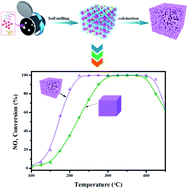Solvent-free rapid synthesis of porous CeWOx by a mechanochemical self-assembly strategy for the abatement of NOx†
Abstract
Herein, we designed and initiated a novel mechanochemical self-assembly protocol that realized a rapid and solvent-free construction of a series of highly porous CeWOx oxides with high specific surface areas up to 143 m2 g−1, and their catalytic activities were examined for selective catalytic reduction of NOx with NH3 (NH3-SCR). Experimental results revealed that Ce0.8W0.2Ox exhibited the broadest activity temperature window for NOx abatement (210–440 °C) and excellent resistance to SO2 and H2O poisoning under a high gas hour space velocity (GHSV = 125 000 h−1) on account of its high specific surface area, abundant acid and redox sites, as well as more exposed active sites. DFT calculations unveiled that the amount of W dopant significantly influenced the structure of active sites, and that Ce0.8W0.2Ox exhibited the lowest oxygen vacancy formation energy (0.84 eV) and the strongest NH3 binding ability (−1.55 eV). Furthermore, kinetics experimental results disclosed that the incorporation of mesopores into CeWOx induced the exposure of more active sites, thereby facilitating the access of reactants to more active sites and the adsorption and activation of ammonia species, thereafter promoting the catalytic performance of CeWOx catalysts. Therefore, this work not only introduces a new opportunity for fabricating a number of advanced porous materials, but also provides insight into the crucial role of mesopores and dopants in heterogeneous catalysis reactions.



 Please wait while we load your content...
Please wait while we load your content...